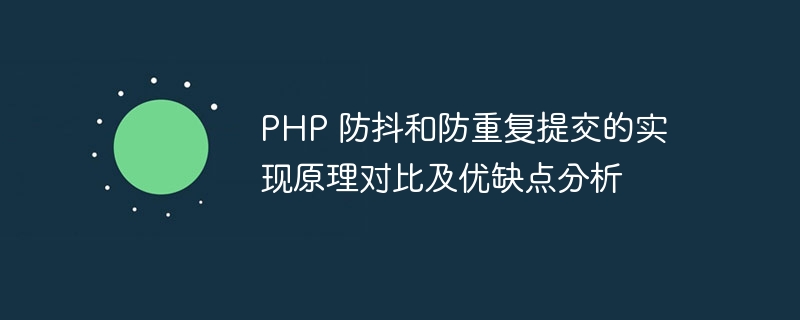Home >Backend Development >PHP Tutorial >Comparison of implementation principles and analysis of advantages and disadvantages of PHP anti-shake and anti-duplicate submission
Comparison of implementation principles and analysis of advantages and disadvantages of PHP anti-shake and anti-duplicate submission
- 王林Original
- 2023-10-12 10:30:53848browse

Comparison of implementation principles and advantages and disadvantages analysis of PHP anti-shake and anti-duplicate submission
Introduction:
In Web development, anti-shake and anti-duplicate submission are Frequently Asked Questions. When users frequently trigger an event, we hope to be able to control the triggering frequency of the event. The anti-shake mechanism can help us reduce unnecessary requests. On the other hand, preventing users from submitting the same form multiple times is also an important security consideration. This article will introduce the principles of anti-shaking and anti-duplicate submission in PHP, as well as their advantages and disadvantages, and demonstrate specific code examples.
1. The implementation principle of anti-shake
The implementation principle of the anti-shake mechanism is relatively simple. When an event is triggered, by setting a timer, if the event is triggered again within the specified time, the timer will be cleared and the timing will start again. The timer will trigger the event normally only after the event stops firing for a period of time.
The sample code is as follows:
function debounce($callback, $delay) {
$timer = null;
return function() use ($callback, $delay, &$timer) {
if ($timer) {
clearTimeout($timer);
}
$timer = setTimeout($callback, $delay);
};
}
// 调用示例
$debounceHandler = debounce(function() {
// 处理具体逻辑
}, 1000);
// 触发事件
$debounceHandler();Advantages:
- It can effectively reduce the frequency of requests and reduce the burden on the server.
Disadvantages:
- The event will not be triggered until it stops triggering, and there will be a certain delay.
2. Implementation Principle of Anti-Duplicate Submission
Anti-duplicate submission means prohibiting repeated submission of the same form after the user submits the form. This can be achieved by generating and saving a random token. When a user submits a form for the first time, a unique token is generated and saved in the session. Each time the form is submitted, we will check whether the token exists in the session. If it exists, the form has been submitted.
The sample code is as follows:
function preventDuplicateSubmission($callback) {
session_start();
$formToken = 'form_token_' . md5($_SERVER['REQUEST_URI']);
if (isset($_POST['token']) && $_POST['token'] === $_SESSION[$formToken]) {
echo '请勿重复提交表单';
return;
}
$token = md5(microtime() . rand(0, 9999));
$_SESSION[$formToken] = $token;
$_POST['token'] = $token;
$callback();
}
// 调用示例
preventDuplicateSubmission(function() {
// 处理具体逻辑
});Advantages:
- It can prevent users from repeatedly submitting the same form, which enhances the security of the system.
Disadvantages:
- The token needs to be saved in the session, which increases the burden on the server.
- Need to generate a unique token for each form, which may have a certain performance impact.
3. Comparison between anti-shake and anti-duplicate submission
Anti-shake and anti-duplication submission are both designed to improve the performance and security of the system, but the applicable scenarios and implementation principles are different.
-
Applicable scenarios:
- Anti-shake is suitable for reducing scenarios with high request frequency, such as input box input events, window size changes, etc.
- Anti-duplicate submission is suitable for scenarios where it is necessary to ensure the uniqueness of form submissions, such as submitting orders, posting comments, etc.
-
Implementation principle:
- Anti-shake delays the triggering event by setting a timer to ensure that the event will not be executed until it stops triggering for a period of time.
- Anti-repeated submission generates and saves random tokens, and uses session to determine whether the form has been submitted.
-
Advantages and Disadvantages:
- Anti-shake can effectively reduce the frequency of requests, but it will bring a certain delay.
- Preventing repeated submissions can ensure the uniqueness of the form, but it will increase the burden on the server and have certain performance impacts.
Conclusion:
Anti-shake and anti-resubmit are both solutions to common web development problems. In actual development, we have to choose the appropriate method according to the specific scenario. If you need to control the frequency of requests, you can use anti-shake; if you need to ensure the uniqueness of form submission, you can use anti-duplicate submission. Of course, we can also use these two methods combined according to needs to provide better user experience and system security.
The above is the detailed content of Comparison of implementation principles and analysis of advantages and disadvantages of PHP anti-shake and anti-duplicate submission. For more information, please follow other related articles on the PHP Chinese website!

